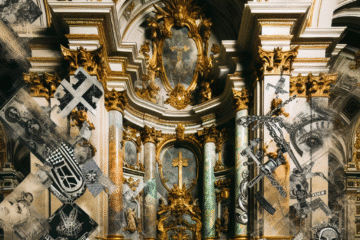
Image title: Hermann von Wedigh III (died 1560)
Medium: Oil and gold on oak
Date: 1532
Source:
The Met Collection
“
The wisest men follow their own direction.
”
— Euripides
“The Frame Is a Lie”: Meta-Artworks That Break Their Own Borders
Introduction: Frame as Fiction
The frame has long served as a boundary—a demarcation between art and the world, imagination and reality, high culture and common experience. But what happens when the artwork turns inward, critiques its own enclosure, or even refuses containment altogether? In this blog post, we explore the evolution of meta-artworks—those that challenge or incorporate their own frames to reflect on perception, context, and commodification. Traversing centuries of art history, we expose how the frame has not only served but been subverted by artists in their quest to disrupt the viewer’s expectations and redefine art’s role in society.
1. Baroque Intrusions and the Illusionistic Frame
In the 17th century, illusionism dominated Baroque painting. Masters like Peter Paul Rubens and Gian Lorenzo Bernini were invested in theatricality and movement, creating works that seemingly spilled out of their frames. These were early stirrings of anti-framing, where the distinction between artwork and observer was intentionally blurred. Consider Andrea Pozzo’s ceiling frescos in churches like Sant’Ignazio in Rome, which create optical illusions that extend the architectural space beyond its physical limits. By visually trespassing their own borders, these works questioned the stability of spatial reality long before postmodern discourse emerged.
2. Modernism and the Desire to Escape the Canvas
The 20th century launched an all-out revolt against the rigid constraints of traditional media. With the birth of Modernism came a fascination with pure form, abstraction, and intellectual exploration. Russian Constructivists created works intended to merge art and life, sometimes installing their pieces directly into living spaces. Kazimir Malevich’s ‘Black Square’ might be read as both a painting and a gravestone for painting itself—a framed void symbolizing the rejection of illusion. Later, Lucio Fontana’s slashed canvases of the 1950s cut through the canvas to open literal portals beyond the picture plane. These interventions pierced not only material surfaces, but the metaphysical ‘frame’ of art’s supposed autonomy.
3. Conceptual Art and Institutional Critique
When Conceptual Art surfaced in the 1960s and ’70s, the frame was no longer a physical object but a system—an institution. Artists like Hans Haacke and Marcel Broodthaers created works that did not merely break the frame, but analyzed it. Broodthaers, once a poet, declared himself a visual artist without changing his content—publishing poems encased in museum-like vitrines to mock the conferring power of the gallery. The real ‘frame’ had become context: the white cube of the gallery, the labels, the price tags, and the social structures around art. Art itself became a means to deconstruct the framing mechanisms of capitalism and cultural authority.
4. Postmodern Play and the Frame as Medium
Postmodernism in the late 20th century continued this trend, blending irony with critique. Artists like Robert Rauschenberg and Jasper Johns turned to assemblage and decollage, incorporating actual frames—or fragments of them—within the art itself. Rauschenberg’s “Combines,” for example, confused painting and sculpture by inserting everyday objects directly into wall-mounted canvases. The frame was no longer boundary but building block, a troped reminder that art is always subject to outside influence. This was the age of self-reference, where the ‘fourth wall’ of visual art was systematically broken and the act of looking became part of the artwork’s message.
5. Contemporary Disruptions: Digital Spaces and Augmented Realities
In the 21st century, technological innovation has further exploded traditional framing. Digital art, NFTs, and augmented reality (AR) reimagine where and how artworks exist—on screens, in virtual environments, or layered over physical spaces via smartphones. Artists like Rafael Lozano-Hemmer and Jenny Holzer create installations that respond to viewer movements and social data, effectively rewriting the parameters of exhibition in real time. The frame, now a metaphysical placeholder, is consistently overwritten. Even the smartphone screen has become both a frame and a canvas, serving as a site of interaction where form is in constant flux and objects can be resold, reprogrammed, and recontextualized endlessly.
Conclusion: The Paradox of the Anti-Frame
To break the frame is also to acknowledge it. Each era’s effort to defy or dissolve the frame reveals its ideological core—from Baroque illusion to Postmodern satire to algorithmic art. These frame-breaking artworks remind us that perception is never neutral and that boundaries—physical, institutional, or technological—always shape what we recognize as ‘Art.’ In destabilizing their containment, meta-artworks invite us to see not just what is pictured, but how and why we look, and where art might begin or end.

Image description:
Meta Forkel Liebeskind, Silhouette
License:
Public domain
Source:
Wikimedia Commons
Useful links:


